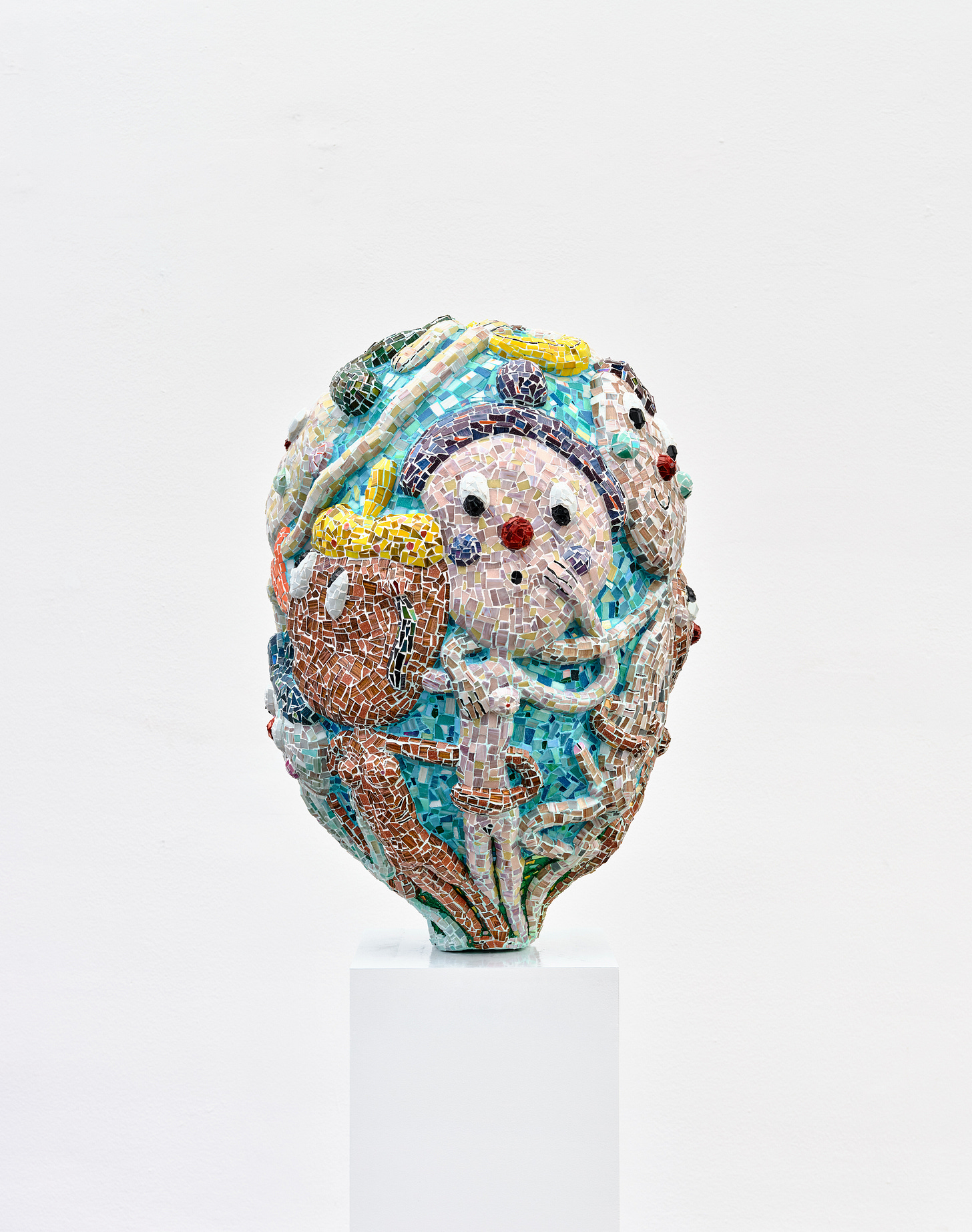I don't remember this episode of Rugrats: Joakim Ojanen at Ruttkowski;68
I paid a last minute visit to the gallery's Düsseldorf space right before they headed into their summer break. Spoiler alert: It was worth it.
Don’t tell Mom!
Joakim’s (Millennial, Swedish) goofy cartoonish figures look misplaced against the gallery’s blank sterile walls. His painted and sculpted protagonists come across as kids who found the space empty and made it their playground until busted by the grown-ups. I’m stumbling into their world of games and shenanigans, unacknowledged as intruder.

Joakim makes spaghetti-legged, pinocchio-nosed, fruit-headed and whimsical animal creatures. They’re rosy-cheeked and plainly dressed. He paints them in tiny choppy lines and curved hooks, often outlining them like in a comic. The result is buzzing and vibrating on the canvas, a TV cartoon I just paused to get my sippy cup. If only there was a remote to press play.
Back in the day…
There’s a loving 90’s cartoon nostalgia to these works, eventhough I can’t pinpoint a specific one. Call Joakim a salmon, cause he’s swimming very much against the stream with these: Childhood classics are getting ruined every day. Everything is shredded through CGI and AI programs and here you have your reboot. Bro when they made Spirit an animated series… I wanted to throw hands. Rugrats got a questionable animation remake in 2021. Strawberry Shortcake sold its soul to shareholder value with quicker production deadlines thanks to animation as well. Needless to continue this depressing list, there’s plenty unfortunately.
With most attention going to digital aesthetics, its refreshing to see an artist not adapting the past to the present but asking how these past aesthetics feel like here and now. Joakim isn’t entirely imitating or copying them, though. Especially in his paintings, the figures are more bulging than real cartoon examples, they’re slightly distorted. That doesn’t result in horror as in Szabolcs Bozó’s (Millennial, Hungarian), paintings, though. It’s rather a reminder of a look into the good old days that might just not feel the same years later.
Joakim’s stories are wholesome, look at the titles: Gentle dance; Flowers for my love; Tell me more, I’m listening; Here's the crown, you deserve it! With the overly positive affirmations, I can’t help but wonder: Is this like a Freud thing? Like childhood trauma? Is this something we need to unpack, or…? I’m questioning whether this might be some attempt at healing childhood trauma and giving oneself the care and love one didn’t get as a child. But maybe this isn’t so much about Joakim and his personal story but a gentle offer to heal the inner child of those who see the works?

Joakim’s mischievous figures find themselves in settings that look like foreign planets and a kid’s birthday party. The painting that gave the show its title, The dance we dance when we are together (2024), brings together two figures doing pottery together. I doubt their success, though, given that their noodly arms are about to get entangled any moment and the clay is splashing left and right. In Ride of our lifes (2023), two silly guys take ride on a creature oddly getting milked by some green alien… Joakim’s worlds aren’t logical, they’re fun!
Colorful drips of paint exploding all around make me think of confetti, unlocking a forgotten memory of Maica sausage commercials I saw while waiting for my daytime cartoon program to continue (only the German kids will understand).
Piece by piece
Three mosaic sculptures rest on pedestals. They’re Joakim’s newer works. Each piece appears to expand like a baloon or cotton candy. Mosaic figures usually make me think of Zsófia Keresztes (Millennial, Hungarian). But Zsófia opts rather for Alice-in-Wonderlandian forms in highly symmetrical compositions that refuse any connection to real world pop culture. And while she smoothes out any gaps between individual mosaic stones to create finished glossy surfaces, Joakim plays with the distances in between, sometimes adding color to them, embracing irregular shapes and varying shades.

Even Joakim’s bronze sculptures are as pasty and flaky as his paintings. Bronze is an intriguing choice. A material usually reserved for monuments of important people and events, it appears rather humble here. Where bronze sculptures usually take up terrain, Joakim now limits their space.
One sculpture – Blowing the horn (calling for friends) (2024) – is pretty much confined to its tiny bronze base, kind of like a giant stuck on a desolate island. The figure can’t even stretch out its legs. The other one is a sad little fella titled Trying to find myself (2024), kneeling in a corner as if punished for a silly prank. Contemplating its naughty behaviour, it holds up a mirror. Just like Michael, it knows that if you want to make the world a better place, you need to take a look in the mirror and make a change.
Several works in the show refer to contemplation and introspection. One mosaic head is frozen in awe, titled Endless thoughts (2024), there’s the small painting Dog in the night thinking (2024) (but wise people always ask what da dog doin’?). Aloofness, curiosity, a sense of wonder. There’s so much of that in Joakim’s art and yet so little in our grown-up daily lives.
Joakim Ojanen: The dance we dance when we are together was on view from June 22 through August 4, 2024, at Ruttkowski;68 in Düsseldorf.
Ruttkowski;68
Grabbeplatz 2
40213 Düsseldorf
Website
Instagram: @ruttkowski68 @joakimojanen
Fine, I’ll rewatch Hey Arnold again. What do you think? Do Joakim’s works make you miss your childhood cartoons, too? Leave me a comment with your thoughts. As a subscriber, don’t forget to hit that like button! And I always appreciate you sharing my reviews, feel free to spread the word. :)
See you soon!!!
Jennifer
The Gen Z Art Critic





